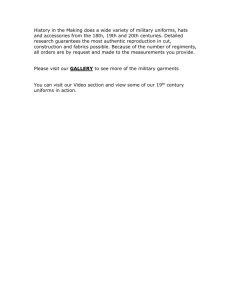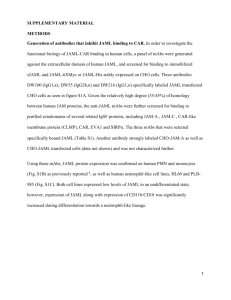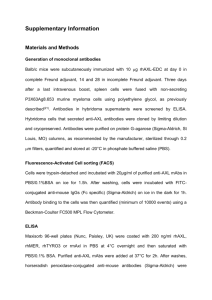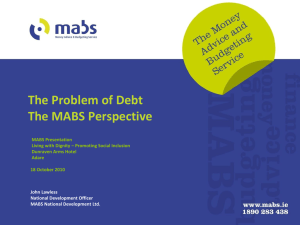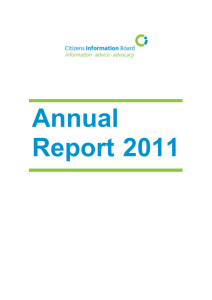(Oireachtas Joint Committee on Education and Social Protection)
advertisement
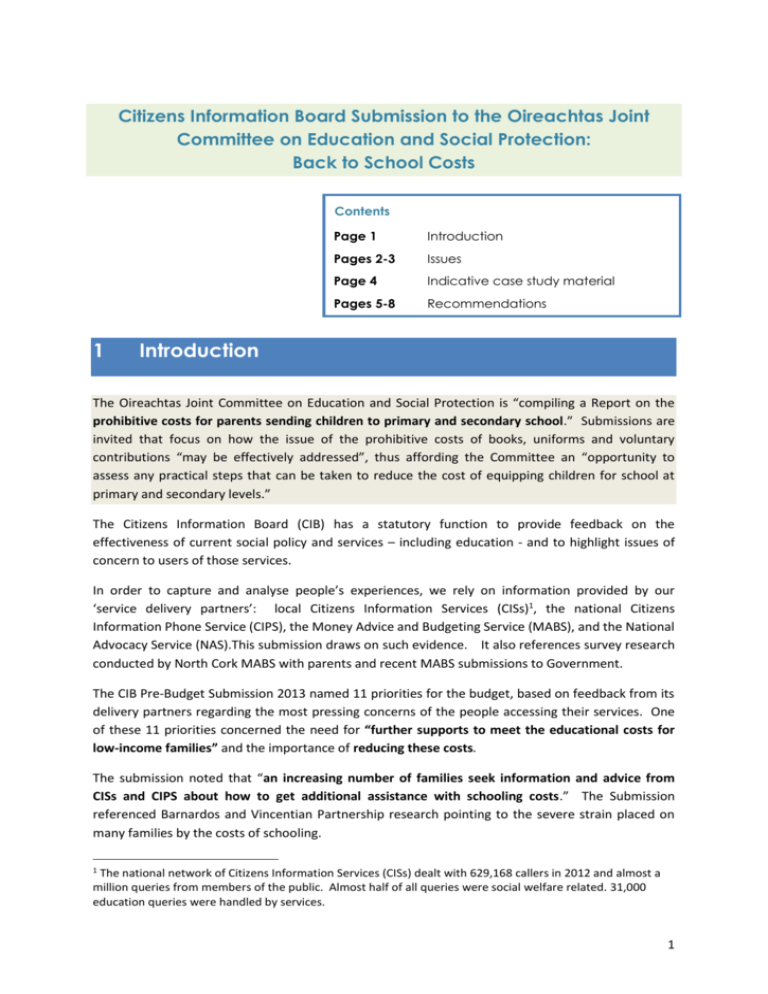
Citizens Information Board Submission to the Oireachtas Joint Committee on Education and Social Protection: Back to School Costs Contents 1 Page 1 Introduction Pages 2-3 Issues Page 4 Indicative case study material Pages 5-8 Recommendations Introduction The Oireachtas Joint Committee on Education and Social Protection is “compiling a Report on the prohibitive costs for parents sending children to primary and secondary school.” Submissions are invited that focus on how the issue of the prohibitive costs of books, uniforms and voluntary contributions “may be effectively addressed”, thus affording the Committee an “opportunity to assess any practical steps that can be taken to reduce the cost of equipping children for school at primary and secondary levels.” The Citizens Information Board (CIB) has a statutory function to provide feedback on the effectiveness of current social policy and services – including education - and to highlight issues of concern to users of those services. In order to capture and analyse people’s experiences, we rely on information provided by our ‘service delivery partners’: local Citizens Information Services (CISs)1, the national Citizens Information Phone Service (CIPS), the Money Advice and Budgeting Service (MABS), and the National Advocacy Service (NAS).This submission draws on such evidence. It also references survey research conducted by North Cork MABS with parents and recent MABS submissions to Government. The CIB Pre-Budget Submission 2013 named 11 priorities for the budget, based on feedback from its delivery partners regarding the most pressing concerns of the people accessing their services. One of these 11 priorities concerned the need for “further supports to meet the educational costs for low-income families” and the importance of reducing these costs. The submission noted that “an increasing number of families seek information and advice from CISs and CIPS about how to get additional assistance with schooling costs.” The Submission referenced Barnardos and Vincentian Partnership research pointing to the severe strain placed on many families by the costs of schooling. 1 The national network of Citizens Information Services (CISs) dealt with 629,168 callers in 2012 and almost a million queries from members of the public. Almost half of all queries were social welfare related. 31,000 education queries were handled by services. 1 2 Issues The following issues emerge most strongly in evidence from our service delivery partners: 2.1 High Cost of Schooling Services report that many clients find themselves in debt at the start of the school year with the costs incurred in children returning to school. In surveys carried out by North Cork MABS in recent years, and in social policy feedback from MABS, CISs and CIPS, the costs of school books2, school uniforms3 and school transport4 have proven to be particularly prohibitive. Other costs, however, also put strain on many families. These include ‘voluntary’ contributions and school outings/tours as well as extra-curricular activities that are in themselves essential as regards full inclusion in school life and access to educational opportunity (see 2.2 below). 2.2 Increasing Risk of Social Exclusion and Stigmatisation The cost of extra-curricular activities/tuition can be high: though not compulsory, such activities are often essential with regard to social/educational inclusion. (Examples named in policy returns from our service delivery partners are swimming lessons and other sports activities; musical instrument tuition where a child is taking music as a school examination subject; and after school/homework support projects.) Children from lower-income families are likely to benefit most and yet be most at risk of exclusion from costly extra-curricular activities and supports. Additionally, a child who has to opt out of school tours/outings is likely to experience social stigma. Success in the Irish school system can be heavily reliant on the capacity of parents to buy ‘grinds’ for their children.5Those children whose parents cannot afford grinds are further disadvantaged. Evidence from MABS suggests that parents may opt to ensure that their children do continue to participate in extra-curricular activities, school tours etc., but that this brings with it the risk of deepening household poverty, which carries with it not only health risks associated with food and 2 In the UK, school text books and photocopied materials, as well as copy books, are provided free of charge, since they are considered to be essential components of free education. “If an item or an activity is part of the school curriculum, then the school must provide it free of charge” http://www.adviceguide.org.uk/scotland/education The grant scheme available for students in State primary and post-primary schools to help with the cost of school books which is mainly aimed at pupils from low-income families and families experiencing financial hardship provides higher grants for DEIS schools. This system does not adequately cater for disadvantaged children attending non-DEIS schools. 3 The majority of schools require school uniforms to be worn. Many continue to insist that the uniform be bought from a particular supplier, which prevents parents from shopping around for much better clothing deals. 4 School transport fees for eligible school students have risen substantially in recent years. Holders of full medical cards can claim exemption. 5 The website www.grinds.ie, which matches tutors with students, estimates the average cost of a single grind to be €27.10 for primary school and €23.63 for secondary school. 2 fuel poverty but also the stress of household indebtedness and social exclusion of the parents/family within the broader community/socio-economic context. 2.3 Cuts in Back to School Clothing and Footwear Allowance (BTSCFA) The Back to School Clothing and Footwear Allowance (BTSCFA) has been reduced in successive budgets, now standing at €200 for children aged 12-17 (or aged 18-22 and in full-time education) and €100 for children aged 4-11. In 2011, the amounts payable were €305 and €200 respectively. This represents a BTSCFA cut of 33% for secondary school children and 50% for primary school children, over a two-year period, at a time when household incomes have been falling and costs of living have increased quite substantially (e.g. food and fuel costs).6 2.4 BTSCFA not available to all Low-Income Families Many low-income working families are not in receipt of social welfare. They are therefore not entitled to a BTSCFA payment, even where their income is below or equivalent to a social welfare payment for their family size/type. (See Section 3 – Case Study Material) 2.5 Child Benefit (CB) not meeting school costs/Ending of CB at age 18 Child Benefit payments, used by many families to cover education costs (books, uniforms, voluntary contributions and ancillary costs) have been cut in recent budgets. The MABS Pre-Budget Submission 2013 noted that “child benefit does not cover [educational and related] costs for many families. The impact of this is that there is a risk that parents will borrow to pay for necessary costs associated with the education and social development of their children.” In addition, callers to CISs have reported a struggle to meet the costs of Leaving Certificate year as Child Benefit stops when a child reaches the age of 18, even if they are still a full-time secondary school student. 2.6 Role of education in addressing social inequalities In looking at the costs of schooling, it is important to take into account the crucial role of education at all stages of a child’s life for their development and future well-being. Accordingly, the National Action Plan for Social Inclusion 2007 -2016 included three key high level goals relating to education. According to a 2010 UNICEF Report,7 inequality in educational outcomes is principally driven by socio-economic status. Children who fall behind educationally early in their lives are likely to find themselves at a marked and measurable disadvantage. Since the impact of the costs of schooling is greater on lower income families, these costs may put the children of such families at a greater disadvantage than might otherwise be the case and further compound their position. 6 7 See, for example, the Survey on Living Conditions (SILC) 2011 data UNICEF (2010), The Children Left Behind, Innocenti Research Centre Report Card 9 3 3 Indicative Case Study Material 3 Indicative Case Study Material This family consists of two parents and four children (two secondary-school age, two primary-school age). There are already difficulties with mortgage repayments, utility bills and secondary debt. Father had his own business which failed. He was out of work for 18 months but is now back in the workforce. Mother is a full-time homemaker. On the father’s return to work, the family became eligible for Family Income Supplement, but are not eligible for Back to School Clothing and Footwear Allowance by a small amount. One child is starting first year in secondary school. Between the cost of the new uniform (this school has an exclusive supplier of uniforms & also requires a school coat), a set of books (none of which could be passed down from his older sibling as there had been a change in the text books), the ‘voluntary contribution’, shoes and other school supplies, this family estimated a cost of €800 to get just this one of their four children back to school. The mother informed me that she had considered not sending their children back to school because they could not afford the books required and teachers are putting the children under pressure in the classroom when they are not fully equipped. In the end, they did not pay their mortgage for the month of September, putting them further into arrears. Their children, however, returned to school with everything they needed. This lone parent, had been in receipt of Carer’s Allowance while caring for a parent. She also works part time. She had not previously applied for a one parent family payment, and due to budget changes is now ineligible. While on Carer’s Allowance, she received BTSCFA. Her parent died last year, however, and as she now receives no social welfare payment, she is ineligible for BTSCFA. She cannot apply for a jobseeker’s payment as she works five days a week. She is ineligible for FIS as she works less than 38 hours per fortnight. This parent has two children in secondary school. She works part-time but is ineligible for FIS due to the fortnightly 38-hour rule (even though she would qualify on income grounds), so no claim for BTSCFA is possible. The school insists that uniforms be purchased from one particular shop and will not accept ‘standard’ grey pants, etc. The ‘voluntary’ contribution is in excess of €100 per child, and the parent feels that the procedure for requesting exemption or reduction due to ‘impecunious circumstances’ (school terminology) is stigmatising. Does not wish to exclude her children from school outings and activities, but finds the expense of these very difficult to meet. The cost of school books is very high each year, and no book loan scheme is in place. Additional books and exam papers are often required to be bought during the year. The elder child will turn eighteen before the beginning of Sixth Year, so Child Benefit will cease for that student. The parent does not know how she will afford the school costs during that year, as Child Benefit has been used to cover these costs throughout secondary school and the household budget is already stretched to its limit. 4 4 Recommendations The following recommendations relate directly to the issues identified in Section 2 (above). They draw together recommendations previously included in CIB Pre-Budget Submissions and those included in recent policy submissions to CIB from a number of CISs and MABS companies8. The recommendations are in three sections. The first section concerns reduction in school costs. The second section concerns social and educational inclusion. The third section concerns assistance with school costs. It is acknowledged that some of the recommendations are not (in the short-term) cost-neutral; if adopted they will involve some additional expense for schools and/or the State, although it is the case that diversion of funds currently spent elsewhere might form a significant part of the solution.9 It is considered important, however, in the context of addressing exclusion and inequality in the educational context, to make any such reasonably practicable recommendations to the Committee as might have a critical impact on educational exclusion and currently-excessive household expenditure on children’s schooling. Reducing School Costs: Recommendations 4.1 Reduce the cost of school books 4.1.1 All schools (both primary & secondary) should be required to introduce a book rental scheme for all children who wish to avail of it10. 4.1.2 Text books should not be changed by schools unless absolutely necessary, thus enabling parents to hand down books from one child to another or to buy second-hand books. Publishers should be encouraged to print addendums to books rather than require the purchase of a new text where essential new information must be added to a course. Alternatively, schools themselves might distribute additional photocopied information/addendums. 8 CIB is particularly indebted to Greater Blanchardstown MABS, North Cork MABS and Laois MABS in this regard. Case study material/qualitative evidence also provided by Clare CIS, Co Roscommon CIS and the Citizens Information Phone Service (CIPS). 9 One MABS company suggested in its policy return, for example, that some of the funding channelled into the subsidising of fee-paying schools might be more equitably spent on enabling the full participation in state schools of the children from lower-income families. 10 The launch of new “Guidelines for Developing Textbook Rental Schemes in Schools” January 2013 by the Minister for Education and Skills is to be welcomed. 5 4.1.3 Schools to be encouraged to consider the system already adopted in some schools whereby parents purchase i-Pads (or similar tablets) through the school, onto which books can be uploaded. Bulk-buy discounts could be negotiated, and an affordable instalment-payment purchasing system set up. 4.2 Reduce the cost of school uniforms All schools requiring school uniforms should permit the wearing of ‘standard’ school clothing (plaincoloured pants, shirts, track suits. coats etc.), rather than insisting upon tailor-made uniforms that can be bought only through an exclusive supplier. (The awarding of exclusive contracts to one supplier should be discontinued.) Schools should be required to make iron-on school crests available. This should significantly reduce the cost of school uniforms. A move away from tailor-made school uniforms would also facilitate the purchase of second-hand school clothing. This latter could be further facilitated through systems whereby parents are actively encouraged by schools to donate good-quality used school clothing to a particular outlet (e.g. a local Vincent de Paul shop), either directly or via a school drop-off/pick-up point. (This facilitative system for second-hand uniform purchase could also be used for still-useable second-hand text books.) 4.3 Set a National Limit for Voluntary Contributions While it is recognised that schools are currently reliant to some degree on parental contributions in order to meet their running costs, it is proposed that the DES recommend that the voluntary contribution requested should not exceed €50 per child per school year. (Schools might request that those parents in a position to make higher payments consider voluntarily doing so, rather than asking parents in difficult financial circumstances to make a case for reducing their contribution.) 4.3 Reduce or Freeze the cost of School Transport/Facilitate Shared Arrangements It is acknowledged that families with full medical cards, whose children are eligible for school transport, are entitled to claim such transport free of charge. The cost, however, for those who (perhaps marginally) fail to qualify for a full medical card is high, particularly where more than one child is travelling on the school bus. It is therefore recommended that attention be given to the cost of such transport, which should either be reduced or protected from further increases. In addition, schools and/or parent associations might be actively encouraged to facilitate car-pooling or supervised-walk-to-school arrangements. 6 Addressing Exclusion: Recommendations 4.4 Reduce the cost of school tours/extra-curricular activities All schools to be required to set an upper limit for the annual school tour, to encourage schools to negotiate best-possible travel/activities deals. This would help to avoid the social exclusion of children whose families are unable to meet the often-prohibitive cost of such tours. Where extracurricular educational activities (e.g. music lessons) are provided in the school setting by an external tutor, the schools should attempt to negotiate a preferential rate for their students, given that there are clear benefits to the tutor inherent in their relationship with the school (e.g. re pool of students in single location). 4.5 Expand school meals programmes 11 The positive impact of school meals provision is well-documented, particularly at a time of increasing food poverty. Further expansion of school meals provision in schools is required to cater for children in low income families. Educational and life-chances are positively impacted by the nutritional and social value of universally-available food within the school context, which has also been shown to have a dramatic effect on pupils' concentration and behaviour. 12Service delivery providers at CIB policy events have suggested many low-cost approaches to the introduction of healthy food in the school context, such as combining provision with education (e.g. teaching children to make and encouraging them to eat low-cost, nutritional food such as porridge within breakfast club settings open to all; developing mutually-beneficial relationships with food retailers etc.) It is recommended that the community/school initiatives promoted by Healthy Food for All be significantly expanded.13 11 The additional €2 million allocated to the school meals programme in this year’s budget is welcomed. See for example http://www.opfs.org.uk/policy/briefings/school-meals 13 See http://www.healthyfoodforall.com/ 12 7 Assistance with School Costs: Recommendations 4.7 Expand the eligibility criteria for BTSCFA Expand the BTSCFA net (giving consideration to tapered provision) to include low-income families who do not qualify for social welfare payments (e.g. self-employed people; employees not meeting the qualifying conditions for FIS even though below income threshold) and to include all those who are in receipt of FIS.14 Consideration might also be given to channelling BTSCFA payments directly to schools in tandem with a book rental scheme/uniform purchase scheme.15 4.8 Restore Child Benefit for 18-year-olds still in full-time secondary schooling The restoration of Child Benefit to parents who are supporting children to remain in school until completion of the Leaving Certificate should impact not only on household poverty, indebtedness and financial stress, but also upon early school leaving. Students who leave school prior to sitting the Leaving Certificate, are more likely to become welfare dependent. The restoration of Child Benefit for those still in full-time schooling should therefore help to militate against a more entrenched, longer-term welfare dependence. 14 CIB continues to support the subsuming of BTSCFA into a child income support supplement, paying the supplement at a higher rate at critical times with respect to school costs; in the absence of structural changes to child income supports, however, our recommendation is for a broadening of the eligibility criteria for the current scheme. 15 Comment from a MABS Money Adviser: “In my experience [BTSCFA] money sourced earlier in the summer is spent on electricity or other bills with a little for school. But then approaching September there is panic to make up the money required.” 8
